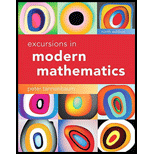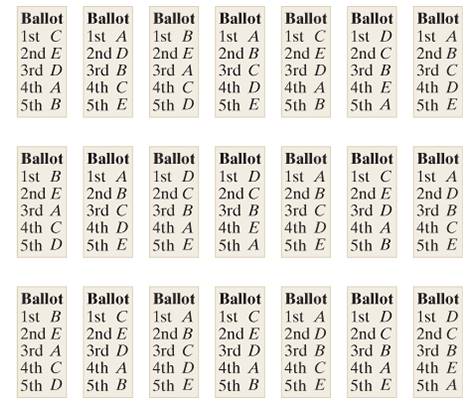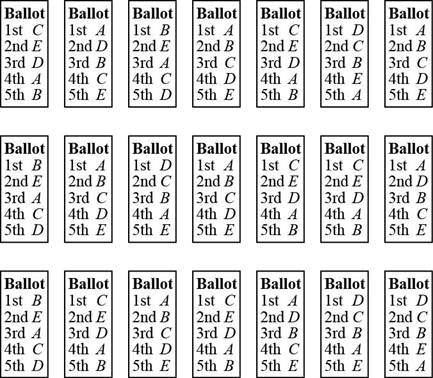
Concept explainers
Figure 1-8 shows the preference ballots for an election with 21 voters and 5 candidates. Write out the preference schedule for this election.

Figure 1-8
To find:
The preference schedule for the election with given preference ballots.
Answer to Problem 1E
Solution:
The preference schedule for the preference ballots for 21 voters and 5 candidates is,
| Number of Voters | 5 | 5 | 3 | 3 | 3 | 2 |
| 1st Choice | A | C | A | B | D | D |
| 2nd Choice | B | E | D | E | C | C |
| 3rd Choice | C | D | B | A | B | B |
| 4th Choice | D | A | C | C | E | A |
| 5th Choice | E | B | E | D | A | E |
Explanation of Solution
Given:
The preference ballots for 21 voters and 5 candidates are given as,

Calculation:
The ballots of the same preferences are grouped together as,

The preference schedule table for the above ballots is given by,
| Number of Voters | 5 | 5 | 3 | 3 | 3 | 2 |
| 1st Choice | A | C | A | B | D | D |
| 2nd Choice | B | E | D | E | C | C |
| 3rd Choice | C | D | B | A | B | B |
| 4th Choice | D | A | C | C | E | A |
| 5th Choice | E | B | E | D | A | E |
Conclusion:
The preference schedule for the preference ballots for 21 voters and 5 candidates is,
| Number of Voters | 5 | 5 | 3 | 3 | 3 | 2 |
| 1st Choice | A | C | A | B | D | D |
| 2nd Choice | B | E | D | E | C | C |
| 3rd Choice | C | D | B | A | B | B |
| 4th Choice | D | A | C | C | E | A |
| 5th Choice | E | B | E | D | A | E |
Want to see more full solutions like this?
Chapter 1 Solutions
Excursions in Modern Mathematics (9th Edition)
Additional Math Textbook Solutions
Pathways To Math Literacy (looseleaf)
Precalculus: Mathematics for Calculus (Standalone Book)
Elementary Statistics ( 3rd International Edition ) Isbn:9781260092561
APPLIED STAT.IN BUS.+ECONOMICS
Finite Mathematics for Business, Economics, Life Sciences and Social Sciences
- Q4. We want to invest $18000 in an account compounded continuously. How long should the investment be kept so final value of the account reaches $25000 if the annual rate of interest is 5.8%?arrow_forwardQ3. Determine the effective annual yield for each investment below. Then select the better investment. Assume 365 days in a year. a) 5.6% compounded semiannually; b) 5.4% compounded daily.arrow_forwardQ2. You deposit $22,000 in an account that pays 4.8% interest compounded monthly. a. Find the future value after six years. & b b. Determine the effective annual yield of this account.arrow_forward
- The X is a variable in the picture, not a multiplication sign. After the variables the number is a power like X to the power of 9 Could I get assistance on how to solve this problem?arrow_forwardhow to do question 10 where u have to graph and then find domain and range. 10. y= 4x^2+24x+13arrow_forward18. Using the method of variation of parameter, a particular solution to y′′ + 16y = 4 sec(4t) isyp(t) = u1(t) cos(4t) + u2(t) sin(4t). Then u2(t) is equal toA. 1 B. t C. ln | sin 4t| D. ln | cos 4t| E. sec(4t)arrow_forward
- Question 4. Suppose you need to know an equation of the tangent plane to a surface S at the point P(2, 1, 3). You don't have an equation for S but you know that the curves r1(t) = (2 + 3t, 1 — t², 3 − 4t + t²) r2(u) = (1 + u², 2u³ − 1, 2u + 1) both lie on S. (a) Check that both r₁ and r2 pass through the point P. 1 (b) Give the expression of the 074 in two ways Ət ⚫ in terms of 32 and 33 using the chain rule მყ ⚫ in terms of t using the expression of z(t) in the curve r1 (c) Similarly, give the expression of the 22 in two ways Əz ди ⚫ in terms of oz and oz using the chain rule Əz მყ • in terms of u using the expression of z(u) in the curve r2 (d) Deduce the partial derivative 32 and 33 at the point P and the equation of მე მყ the tangent planearrow_forwardCoast Guard Patrol Search Mission The pilot of a Coast Guard patrol aircraft on a search mission had just spotted a disabled fishing trawler and decided to go in for a closer look. Flying in a straight line at a constant altitude of 1000 ft and at a steady speed of 256 ft/s, the aircraft passed directly over the trawler. How fast (in ft/s) was the aircraft receding from the trawler when it was 1400 ft from the trawler? (Round your answer to one decimal places.) 1000 ft 180 × ft/s Need Help? Read It SUBMIT ANSWERarrow_forward6. The largest interval in which the solution of (cos t)y′′ +t^2y′ − (5/t)y = e^t/(t−3) , y(1) = 2, y′(1) = 0is guaranteed to exist by the Existence and Uniqueness Theorem is:A. (0, ∞) B. (π/2, 3) C. (0,π/2) D. (0, π) E. (0, 3)arrow_forward
- Use a . Venn Diagram (Euler Diagram) or truth table to decide whether each argument is valid or invalid Some of these kids are rude. Jimmy is one of these kids. Therefore, Jimmy is rude! Premise: Some of the kids are rude. Premise: Jimmy is one of these kids. Conclusion: Jimmy is rude! I dont have an image. Do you reallly need one?arrow_forward12. For the differential equation in the previous question, what is the correct form for a particularsolution?A. yp = Ae^t + Bt^2 B. yp = Ae^t + Bt^2 + Ct + DC. yp = Ate^t + Bt^2 D. yp = Ate^t + Bt^2 + Ct + D Previous differential equation y′′ − 4y′ + 3y = e^t + t^2arrow_forward16. The appropriate form for the particular solution yp(x) of y^(3) − y′′ − 2y′ = x^2 + e^2x isA. yp(x) = Ax^2 + Bx + C + De^2x B. yp(x) = Ax^3 + Bx^2 + Cx + Dxe^2xC. yp(x) = Ax^2 +Be^2x D. yp(x) = A+Be^2x +Ce^−x E. yp(x) = Ax^2 +Bx+C +(Dx+E)e^2xarrow_forward
 Discrete Mathematics and Its Applications ( 8th I...MathISBN:9781259676512Author:Kenneth H RosenPublisher:McGraw-Hill Education
Discrete Mathematics and Its Applications ( 8th I...MathISBN:9781259676512Author:Kenneth H RosenPublisher:McGraw-Hill Education Mathematics for Elementary Teachers with Activiti...MathISBN:9780134392790Author:Beckmann, SybillaPublisher:PEARSON
Mathematics for Elementary Teachers with Activiti...MathISBN:9780134392790Author:Beckmann, SybillaPublisher:PEARSON
 Thinking Mathematically (7th Edition)MathISBN:9780134683713Author:Robert F. BlitzerPublisher:PEARSON
Thinking Mathematically (7th Edition)MathISBN:9780134683713Author:Robert F. BlitzerPublisher:PEARSON Discrete Mathematics With ApplicationsMathISBN:9781337694193Author:EPP, Susanna S.Publisher:Cengage Learning,
Discrete Mathematics With ApplicationsMathISBN:9781337694193Author:EPP, Susanna S.Publisher:Cengage Learning, Pathways To Math Literacy (looseleaf)MathISBN:9781259985607Author:David Sobecki Professor, Brian A. MercerPublisher:McGraw-Hill Education
Pathways To Math Literacy (looseleaf)MathISBN:9781259985607Author:David Sobecki Professor, Brian A. MercerPublisher:McGraw-Hill Education





